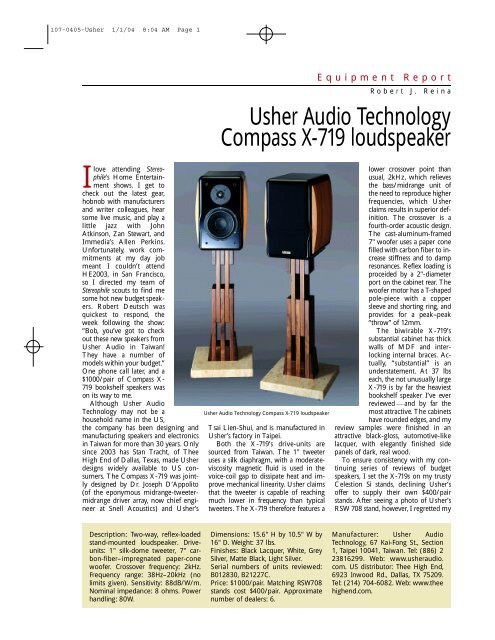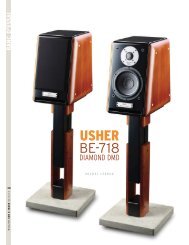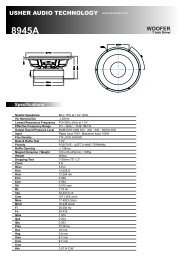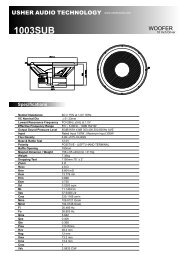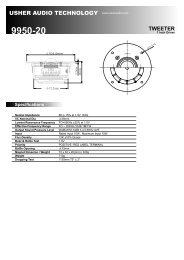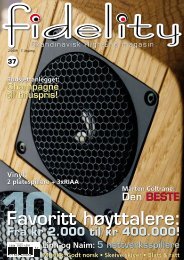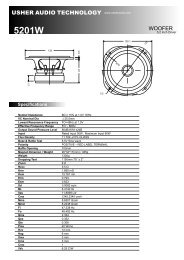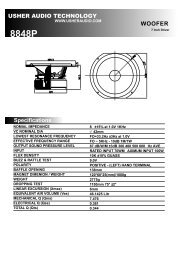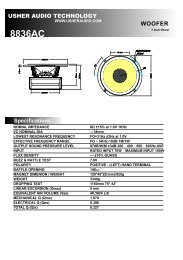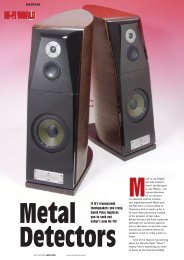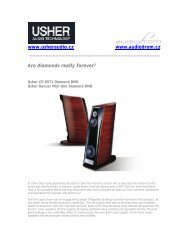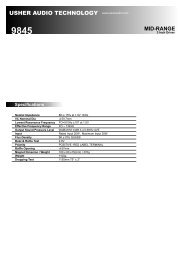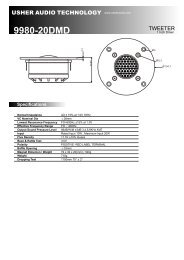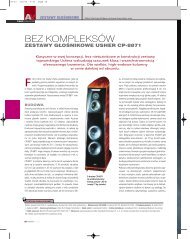Usher Audio Te c h n o l o gy Compass X-719 loudspeaker
Usher Audio Te c h n o l o gy Compass X-719 loudspeaker
Usher Audio Te c h n o l o gy Compass X-719 loudspeaker
Create successful ePaper yourself
Turn your PDF publications into a flip-book with our unique Google optimized e-Paper software.
107-0405-<strong>Usher</strong> 1/1/04 8:04 AM Page 1E q u i p m e n t R e p o r tR o b e r t J . R e i n a<strong>Usher</strong> <strong>Audio</strong> <strong>Te</strong> c h n o l o <strong>gy</strong><strong>Compass</strong> X-<strong>719</strong> <strong>loudspeaker</strong>Il ove attending S t e r e o-p h i l e’s Home Entertainmentshow s. I get tocheck out the latest gear,hobnob with manufacture r sand writer colleagues, hearsome live music, and play alittle jazz with JohnA t k i n s o n, Zan Stew a r t, andImmedia’s Allen Pe r k i n s.Un f o r t u n a t e l y, work commitmentsat my day jobmeant I couldn’t attendHE2003, in San Francisco,so I directed my team ofS t e r e o p h i l escouts to find mesome hot new budget speaker s. Robert Deutsch wasquickest to re s p o n d, theweek following the show :“ Bob, yo u ’ ve got to checkout these new speakers fro m<strong>Usher</strong> <strong>Audio</strong> in Ta i w a n !Th ey have a number ofmodels within your budget. ”One phone call later, and a$ 1000/pair of <strong>Compass</strong> X-<strong>719</strong> bookshelf speakers wason its way to me.Although <strong>Usher</strong> Au d i o<strong>Te</strong>chnolo<strong>gy</strong> may not be ahousehold name in the US,the company has been designing andmanufacturing speakers and electro n i c sin Taiwan for more than 30 ye a r s. Onlysince 2003 has Stan Tr a c h t, of Th e eHigh End of Dallas, <strong>Te</strong>xa s, made <strong>Usher</strong>designs widely available to US consu m e r s. The <strong>Compass</strong> X- <strong>719</strong> was jointlydesigned by Dr. Joseph D’Appolito(of the eponymous midrange-t we e t e r -midrange driver array, now chief engineerat Snell Ac o u s t i c s) and <strong>Usher</strong>’s<strong>Usher</strong> <strong>Audio</strong> <strong>Te</strong>chnolo<strong>gy</strong> <strong>Compass</strong> X-<strong>719</strong> <strong>loudspeaker</strong>Tsai Lien-S h u i, and is manufactured in<strong>Usher</strong>’s factory in Ta i p e i.Both the X-<strong>719</strong>’s drive-units ares o u rced from Ta i w a n. The 1" twe e t e ruses a silk diaphragm, with a moderateviscositymagnetic fluid is used in thevo i c e -coil gap to dissipate heat and improve mechanical linearity. <strong>Usher</strong> claimsthat the tweeter is capable of re a c h i n gmuch lower in frequency than typicalt we e t e r s. The X- <strong>719</strong> there f o re features al ower cro s s over point thanu s u a l, 2kHz, which re l i eve sthe bass/midrange unit ofthe need to re p roduce higherfrequencies, which <strong>Usher</strong>claims results in superior defin i t i o n. The cro s s over is af o u r t h -o rder acoustic design.The cast-a l u m i n u m -f r a m e d7" woofer uses a paper conefilled with carbon fiber to increase stiffness and to dampre s o n a n c e s. Re f l ex loading isp roceided by a 2"-d i a m e t e rport on the cabinet re a r. Th ewoofer motor has a T-s h a p e dpole-piece with a coppers l e eve and shorting ring, andp rovides for a peak–peak“ t h row” of 12 m m.The biwirable X- <strong>719</strong> ’ ssubstantial cabinet has thickwalls of MDF and interlockinginternal braces. Actu a l l y, “substantial” is anu n d e r s t a t e m e n t. At 37 lbse a c h, the not unusually largeX- <strong>719</strong> is by far the heav i e s tbookshelf speaker I’ve eve rrev i ewe d — and by far themost attractive. The cabinetsh ave rounded edges, and myrev i ew samples we re finished in ana t t r a c t i ve black-g l o s s, automotive -l i k el a c q u e r, with elegantly finished sidepanels of dark, real wo o d.To ensure consistency with my continuingseries of rev i ews of budgets p e a k e r s, I set the X- <strong>719</strong>s on my tru s t yCelestion Si stands, declining <strong>Usher</strong>’soffer to supply their own $400/pairs t a n d s. After seeing a photo of <strong>Usher</strong>’sR S W 708 stand, howeve r, I re g retted myDescription: Tw o - w a y, reflex-loadedstand-mounted <strong>loudspeaker</strong>. Driveunits:1" silk-dome tweeter, 7" carbon-fiber–impregnatedpaper-conew o o f e r. Crossover frequency: 2kHz.Frequency range: 38 H z – 20kHz (nolimits given). Sensitivity: 88dB/W/m.Nominal impedance: 8 ohms. Po w e rhandling: 80W.Dimensions: 15.6" H by 10.5" W by16" D. Weight: 37 lbs.Finishes: Black Lacquer, White, GreyS i l v e r, Matte Black, Light Silver.Serial numbers of units reviewed:B 0128 30, B21227 C .Price: $ 10 0 0 / p a i r. Matching RS W 70 8stands cost $400/pair. Approximatenumber of dealers: 6.Manufacturer: <strong>Usher</strong> <strong>Audio</strong><strong>Te</strong> c h n o l o <strong>gy</strong>, 67 Kai-Fong St., Section1, Taipei 10 0 41, Taiwan. <strong>Te</strong>l: (886) 223816 299. Web: www. u s h e r a u d i o .com. US distributor: Thee High End,6 9 23 Inwood Rd., Dallas, TX 7520 9 .<strong>Te</strong>l: (214) 704-6082. Web: www. t h e eh i g h e n d . c o m .
107-0405-<strong>Usher</strong> 1/1/04 8:04 AM Page 2U s h e r A u d i o T e c h n o l o g y C o m p a s s X - 7 1 9d e c i s i o n— when coupled with the X-<strong>719</strong>, the stand’s combination of wo o duprights and stone base makes a strikingvisual statement.<strong>Usher</strong>ing in a new soundI tested the X- <strong>719</strong>s with their grilles onand off. Although <strong>Usher</strong> re c o m m e n d sl e aving the grilles off for the most uniformand flat frequency response, anddespite the fact that I felt the X- <strong>719</strong>sounded more transparent and detailedthat way, I pre f e r red listening with thegrilles on, which provided the best integrationof bass, midrange, and highs.The differe n c e s, howeve r, we re subtle.I auditioned the <strong>Usher</strong> <strong>Compass</strong> X-<strong>719</strong>s using a wide range of viny l, CD,and home-theater re c o rd i n g s. I wasimmediately struck by the speaker’s natur a l, detailed midrange. We l l -re c o rd e dfemale vocal soloists, such as MadelinePey roux on Dr e a m l a n d (CD, Atlantic82946-2) and Aimee Mann on B a c h e l o rNo.2 or the Last Remains of the Do d o (C D ,SuperEgo SE002), we re vibrant andr i c h. On his Give It Up to Love (CD, JVCXRCD 0012-2), Mighty Sam McClain’svoice was re p roduced with the re q u i s i t ed e e p, resonant grow l.The X-<strong>719</strong>’s detailed and delicaterendition of well-recorded instrumentswith significant midrange ener<strong>gy</strong>, suchas woodwinds, brass, and acoustic guitar,made the speaker a good match forclassical chamber works such asGeorge Crumb’s Q u es t (L P, Bridge9069), and small-group jazz recordingssuch as Jerome Harris’ take on DukeEllington’s “The Mooche” (fro mEditor’s Choice, Stereophile STPH016-2). With every classical and jazzrecording I played, the X-<strong>719</strong>s “disappe a re d,” all instruments emanatingfrom a wide, deep soundstage.M e a s u r e m e n t sThe <strong>Usher</strong>s arrived at my homerather the worse for we a r, theirsingle packing box and intern a lS t y rofoam inserts not being up to thetask of protecting the speakers fro mthe ravages of UPS. A speaker thishefty needs to be individuallyp a c k e d, in my experience. Fo r t u n-a t e l y, most of the damage was cosme t i c, and while the cro s s over’s largea i r -c o red inductor was hanging by itsconnecting leads in the less damagedFig.1 <strong>Usher</strong> <strong>Compass</strong> X-<strong>719</strong>, electricalimpedance (solid) and phase (dashed).(2 ohms/vertical div.)of the pair (S/N B012830), thespeaker did function corre c t l y. All them e a s u rements we re there f o re performedon this sample, with its grilleoff (the grille fittings had beensnapped off in shipping) .The <strong>Compass</strong> X- <strong>719</strong> is of ave r a g evoltage sensitivity, at an estimated87. 5 d B (B) / 2 . 8 3 V / m, which is withinexperimental error of the specifi e d8 8 d B. Its impedance (fi g.1) lies above8 ohms throughout almost the entirebass and midrange, though it doesd rop to an average of 6 ohms in thet reble. The speaker’s high fre q u e n c i e swill definitely sound less lively with atube amplifier having a high sourc eimpedance, as a result of the ove r a l ld i f f e rence between the midrange andt reble impedances. I would have classi fied the <strong>Usher</strong> as being very easy foran amplifier to drive, we re it not forthe combination of 5.4 ohms magnitudeand –43° phase angle at 2.5kHz.The slight wrinkle in the impedancetraces at around 450Hz impliesthe existence of some kind of cabinetresonance. Examining the panels’vibrational behavior did indeed reve a la single strong mode present at 461 H zon the sidewalls (fi g. 2), though thismight well be high enough in frequencyto “fall between the cracks”with concert-pitch music. (The higherthe “Q,” or “Quality Factor,” of a re s-onance, the longer it needs to be stimulatedwith exactly the rightf requency to be fully ex c i t e d. )The saddle at 41Hz in the impedan c e -magnitude trace suggests thatthis is the tuning frequency of the 2"-diameter port on the rear panel. Th i sis confirmed both by the sharp notchat 41Hz in the woofer’s nearfield outputand the broad peak in the port’sresponse centered on the same frequency(fi g. 3). Two sharp peaks, at350Hz and 78 0 H z, can be seen in theport’s output above its passband, suggestingthe presence of resonances atthese fre q u e n c i e s. Suspiciously, thereFig.2 <strong>Usher</strong> <strong>Compass</strong> X-<strong>719</strong>, cumulative spectral-decay plot calculated from the output of anaccelerometer fastened to the cabinet’s side panel. (MLS driving voltage to speaker, 7.55V;measurement bandwidth, 2kHz.)Fig.3 <strong>Usher</strong> <strong>Compass</strong> X-<strong>719</strong>, acousticcrossover on tweeter axis at 50",corrected for microphone response,with nearfield responses of the wooferand port plotted below 300Hz and1kHz, respectively.
107-0405-<strong>Usher</strong> 1/1/04 8:04 AM Page 3I enjoyed the <strong>Compass</strong> X- <strong>719</strong> mostwith piano re c o rd i n g s, re g a rdless ofg e n re. Bill Evans’ axe on Live at theVillage Va n g u a r d(L P, Riverside RS 3006)was re p roduced with all its warmth,d e t a i l, and subtle dynamic inflectionsi n t a c t. On the opposite side of the spectru m, To ru Takemitsu’s Corona: LondonVe r s i o n (L P, Decca HEAD 4) uses aclosely miked piano as a perc u s s i o ni n s t ru m e n t, with unusually wide variationsof dynamics, from the subtle to theex p l o s i ve, as well as considerable use ofopen space and air —the piece might aswell be titled When Pianos Attack. Th eX- <strong>719</strong>’s wide dynamic range enabledthe piano on this challenging re c o rd i n gto bloom as in a live performance.Higher in fre q u e n c y, the X- <strong>719</strong> tookon a bit of a forward perspective. Th i swas not brightness, harshness, or colorationbut, with works that had significanthigh-f requency content, wasequivalent to moving a few rows closerto the concert-hall stage. This perspecti ve resulted in an attractively crisp presentationof percussion on classical andjazz wo r k s. Steve Nelson’s vibraphonesolo on “The Mooche” sounded vibrantand tactile, reminiscent of a live performanceheard from a front table in a jazzclub; and according to my listeningn o t e s, the marimba on Messiaen’s DesC a n yons Aux Etoiles (L P, Erato ST V70 974 - 75) was “startlingly natural. ”Although the Hammond B-3 organon the Mighty Sam disc sounded re a l i s-t i c, during solos it seemed as if thei n s t rument’s 1' and 2' drawbars hadbeen pulled open another notch. However, despite the more forward perspecti ve, the X- <strong>719</strong>’s high frequencies didn’tsound as detailed or as delicately presentedas its midrange, particularly withclassical wo r k s. More ove r, when thespeaker was pressed hard during highlymodulated orchestral wo r k s, such asElliot Carter’s Double Concerto forH a r p s i c h o rd and Two Chamber Orchestras(L P, Nonesuch H- 71312) or theMessiaen track, strings, brass, and highfrequency percussion instruments tendedto sound a bit steely and brash.The X- <strong>719</strong>’s bass performance wasunlike that of any other speaker I’veh e a rd. With all re c o rd i n g s, the bass wasf o rc e f u l, forward, dramatic, and deep(JA’s measurements will tell us just h o wd e e p). But in searching for a wo rd todescribe the bass, the only wo rd I canthink of is b u x o m. With every re c o rd i n gI used, I kept thinking of . . . D o l l yPa r t o n. Adrienne Barbeau. KittenN a t i v i d a d. That is: ro u n d, tight, we l l -d e fi n e d, dramatic, warm, supple, butslightly larger than life. Scott La Faro ’ ssolos on the live Bill Evans re c o rd i n gbloomed with good defi n i t i o n, and althoughthe bass presentation was ratherM e a s u r e m e n t sis a small suckout in the woofer’s responseat 350Hz.The cro s s over between the wo o f e rand the tweeter lies just below thes p e c i fied 2kHz, with what appears tobe a third -o rder slope to the twe e t e r ’ sh i g h -pass fi l t e r. The woofer’s rolloff ism o re shallow, broken by peaks at3 k H z, 8kHz, and just above 10 k H z.The tweeter’s output is even in thebottom part of its passband, but thereis a little too much on-axis ener<strong>gy</strong> around10 k H z. This boost is still apparentwhen the X- <strong>719</strong>’s farfield outputis averaged across a 30° horizontalw i n d ow on the tweeter axis (fi g. 4) .Together with the slight excess ofFig.5 <strong>Usher</strong> <strong>Compass</strong> X-<strong>719</strong>, vertical response family at 50", normalized to response on tweeteraxis, from back to front: differences in response 45°–5° above axis, reference response,differences in response 5°–45° below axis.Fig.4 <strong>Usher</strong> <strong>Compass</strong> X-<strong>719</strong>, anechoicresponse on tweeter axis at 50",averaged across 30° horizontal windowand corrected for microphone response,with the complex sum of the nearfieldwoofer and port responses, taking intoaccount acoustic phase and distancefrom the nominal farfield point, plottedbelow 300Hz.Fig.6 <strong>Usher</strong> <strong>Compass</strong> X-<strong>719</strong>, lateral response family at 50", normalized to response on tweeteraxis, from back to front: differences in response 90°–5° off-axis, reference response,differences in response 5°–90° off-axis.
107-0405-<strong>Usher</strong> 1/1/04 8:04 AM Page 4U s h e r A u d i o T e c h n o l o g y C o m p a s s X - 7 1 9ro u n d, there was no sense of coloration,ove r h a n g, or sluggishness.When I played we l l -re c o rded electronic rock re c o rdings at higher vo l-u m e s, the <strong>Usher</strong>’s bass performance waseven more dramatic. On “Feel NoPa i n,” from Sade’s Love De l u x e (C D ,Epic EK 53178), the portamento fro mthe lowe r -register bass synth shook theroom with ext r a o rdinary definition andwith no trace of coloration, ove r h a n g, ors t r a i n. Re c o rdings such as this demonstratedthe X- <strong>719</strong>’s seemingly limitlesscapabilities of high-l evel dynamics — byfar the most impre s s i ve I’ve heard fro ma bookshelf speaker this size.I decided to turn up the volume. Th eb a s s -synth blasts on “Electric BattleWeapon 6,” from the Chemical Bro t h e r s ’American EP (L P, Vi r g i n /A s t r a l we r k sASW 43338), are true lease-b re a k e r s. Icranked up the system to about 110 d B.Walls we re shaking. Floors we re shakin g. My dog began barking violently.But the <strong>Usher</strong>s didn’t flinch —d e s p i t emy predilection for listening to delicateWith every recordingI used, I kept thinkingo f . . . Dolly Pa rt o n .Adrienne Barbeau.Kitten Natividad.piano re c o rdings with these speakers,the <strong>Usher</strong>s could party hearty whenasked to.The X- <strong>719</strong>’s most noticeable we a k-ness became evident with busy re c o rdingsthat have considerable pro g r a mmaterial in all frequency ranges. As thespeaker’s high-f requency and bass performanceswe re both rather forward,the midrange sounded a bit laid-back inc o m p a r i s o n, leading to a sense of disco n n e c t e d n e s s. For example, in “Wh e nYou Walk Into My Dre a m s,” from GaryWilson’s You Think You Really Know Me(CD, Motel MR C D 0 07), Wi l s o n ’ srapid Fe n d e r -bass articulations cove rthe instrument’s entire range. The bass’sl ower register was quick, forc e f u l, anddramatic through the <strong>Usher</strong>, the upperregister delicate and laid-back; at times,it sounded as if I was hearing t w o d i f f e r-ent bass players trading riffs.This was not a problem with solopiano or vo c a l -a n d -guitar re c o rd i n g s,but the <strong>Usher</strong> tended to lose cohere n c ea c ross the frequency spectrum whenre p roducing densely orchestrated classicalwo r k s. The re c o rding that best illustratedthe X- <strong>719</strong>’s combination ofs t rengths and weaknesses was AntalDorati’s performance of Strav i n s k y ’ sener<strong>gy</strong> in the two octaves below10 k H z, this will lead to the balancethat Bob Reina described as “forwa rd.” I suspect the upper harmonicsof instruments are being re p roduced alittle too hot in leve l, which he perce i ved as “forwardness” rather than asbrightness per se. As I said in my discussionof the <strong>Usher</strong>’s impedance, thisis something that will be amelioratedif a tube amplifier is used.The suckout around 300Hz is appa rent in this graph, but the bass isactually we l l -ext e n d e d, even allow i n gfor the usual boost that accompaniesthe nearfield measurement technique.BJR described the X- <strong>719</strong>’s bass asbeing “buxom,” but if any t h i n g, Iwould have thought the lows shouldh ave sounded tight as well as deep.F i g.4 was taken on the tweeter axis,and a suckout is apparent at the top ofthe woofer’s passband. F i g. 5 s h ow sthat this suckout fills in 5–10° abovethe tweeter axis, which suggests lowstands would be more appro p r i a t ethan high. BJ R’s 24" stands, for exa m-ple, place the <strong>Usher</strong>’s tweeter 39"f rom the floor, which might ex p l a i nBob’s finding the speaker’s midrangeto sound a bit laid-b a c k. On the otherh a n d, he may have been reacting tothe lack of off-axis ener<strong>gy</strong> in the lateralplane at the top of the woofer’s passband(fi g. 6). Note that the twe e t e rgets decidedly more directional above6 k H z, which in we l l -damped ro o m swill tend to work against the excess ofo n -axis ener<strong>gy</strong> in the same re g i o n.H oweve r, this will make the low treblesound more pro m i n e n t.The X- <strong>719</strong>’s step response (fi g. 7)indicates that both its drive -units areconnected with the same, positiveacoustic polarity. The waterfall plot(fi g. 8) shows a clean initial decay,though there is some delayed ener<strong>gy</strong>associated with the peaks in thewoofer’s out-o f -band behav i o r.<strong>Usher</strong>’s <strong>Compass</strong> X- <strong>719</strong> offers a lotof speaker for $1000/pair: it’s we l l -made, we l l -fi n i s h e d, has high-q u a l i t yp a r t s, and its powe r f u l, extended lowf requencies are unusual in this pricere g i o n. Still, its measured performancedoes reveal some anomalies.— John AtkinsonFig.7 <strong>Usher</strong> <strong>Compass</strong> X-<strong>719</strong>, step responseon tweeter axis at 50" (5ms timewindow, 30kHz bandwidth).Fig.8 <strong>Usher</strong> <strong>Compass</strong> X-<strong>719</strong>, cumulative spectral-decay plot at 50" (0.15ms risetime).
107-0405-<strong>Usher</strong> 1/1/04 8:04 AM Page 5F i r e b i r d Suite (L P, Mercury LivingP resence SR 90226). The orchestra wasp o r t r ayed as big, bright, dynamic, andvibrant across a wide, deep stage, notsounding for a minute as if I was play i n ga re c o rding through bookshelf speakers.The bass-d rum thw a c k s, although a tadlarger than life and with a slight bit ofove r h a n g, shook the room with no traceof coloration or artificial re s o n a n c e .H oweve r, during the densely orc h e s t r a t-ed tuttis, the trumpets and upper-re g i s-ter trombones we re a bit too forwardand blatty, and the somewhat forwardp e r s p e c t i ve of the Mercury LivingP resence “sound” was quite appare n t.Do they compete ?I compared the <strong>Usher</strong> <strong>Compass</strong> X- <strong>719</strong>( $ 1000/pair) with the NHT SB- 3($600/pair), the Polk RT 2 5 i( $ 319/pair), and the Alón by Ac a r i a nSystems Petite ($1000/pair). (The lastt wo models have been discontinued. )The Polk RT25i impressed me withits dead-neutral midrange, soundingeven more natural than the <strong>Usher</strong>, butwithout as much body as the <strong>Usher</strong> inthe midrange. The Polk’s high fre q u e n-cies we re even more extended and delicatethan the <strong>Usher</strong>’s. Although thePolk’s mid- and upper bass we re lessc o l o red than the <strong>Usher</strong>’s, the <strong>Usher</strong>’sA s s o c i a ted EquipmentAnalog sources: V PI TNTM k.IV turntable, Immedia RPMt o n e a r m, Koetsu Urushi MCphono cartridge; Rega Planar 3t u rntable, Syrinx PU-3 tonearm,Clearaudio Virtuoso Wo o d,Au rum Beta S cartridges.Digital sources: C a l i f o rnia Au d i oLabs Icon Mk. II Power Bo s s,C reek CD53 Mk. II CD playe r s ;Pioneer DV-333 DVD playe r.P reamplification: Ve n d e t t aRe s e a rch SCP-2D phono stage,<strong>Audio</strong> Va l ve Eklipse line stage.Power amplifier: <strong>Audio</strong> Re s e a rc hV T 100 Mk. II.Integrated amplifier: C re e k5350 SE.Cables: I n t e rconnect: MIT MI-350 CVTwin <strong>Te</strong> r m i n a t o r, MI-330 SG, <strong>Te</strong> r m i n a t o r. Speaker:Acarian Systems Black Orpheus.Accessories: Various by ASC,Bright Star, Celestion, EchoB u s t e r s, Salamander Designs,Simply Phy s i c s, Sound Anchor,V PI.— Robert J. Reinal ow frequencies we re far more ext e n d-e d, and the speaker trounced the Polk inits ability to provide high-l evel dynamicslam without compression or strain.The NHT SB-3 sounded swe e t e rand more romantic than the <strong>Usher</strong>. Itsvocal re p roduction was as rich, butm o re delicate, and its high fre q u e n c i e swe re more detailed. The NHT’s low -l evel dynamic articulation seemed morecontinuous and involving than theU s h e r ’ s, and its integration of midrange,h i g h s, and bass was far more cohere n t.C u r i o u s l y, the <strong>Compass</strong>X - <strong>719</strong> performed bestwith delicate, simpleacoustic music a n dbombastic, electronicrock recordings.H oweve r, the NHT’s bass was not asb l o o my or as forc e f u l, and, at high level s, the SB-3 suffered from compre s-s i o n. More ove r, the NHT soundedm o re closed-d own than the <strong>Usher</strong>, andlike a much smaller speaker.F i n a l l y, the Alón Petite was far superiorto the <strong>Usher</strong> in overall neutrality,c o h e rence, detail re s o l u t i o n, and delicacyacross the frequency spectru m. Th e<strong>Usher</strong>’s bass went far deeper, howeve r,and the X- <strong>719</strong> was much better than theAlón in terms of high-l evel dynamicarticulation and sense of power withoutc o m p ression or strain.Summing upI enjoyed the time I spent listening to awide range of program materialt h rough the <strong>Compass</strong> X- <strong>719</strong> s. Curio u s l y, they performed best with delica t e, simple acoustic music, such as solopiano re c o rd i n g s, a n d b o m b a s t i c, electronic rock re c o rd i n g s. In addition,while its low -f requency character ism o re buxom than sticlty accurate, theX- <strong>719</strong>’s bass extension and high-l eve ldynamic capability have set new benchmarksfor a bookshelf speaker.Whether or not the <strong>Usher</strong> Au d i o<strong>Te</strong>chnolo<strong>gy</strong> <strong>Compass</strong> X- <strong>719</strong> is right foryou will depend on your musical tastes,listening biases, and associated equipme n t. In any eve n t, the dro p -d e a d -g o r-geous <strong>Compass</strong> X- <strong>719</strong> is a we l c o m eaddition to the American marketplace. Ilook forward to hearing other <strong>Usher</strong>s p e a k e r s.s


